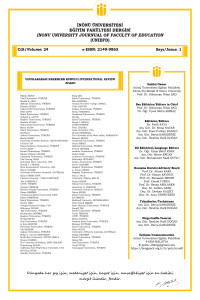Öz
Bu çalışma, yönlendirici söz eylem kategorisindeki “ask” ve “request” yönerge fiillerinin semantik ve söz dizimsel özelliklerini araştırır. Çalışmaya yön veren araştırma soruları şunlardır: (1) “Ask” ve “request” söz eylemlerinin benzer ve farklı semantik özellikleri nelerdir? (2) “Ask” ve “request” söz eylemlerinin benzer ve farklı sözdizimsel özellikleri nelerdir? Bu sorular ışığında, aynı kategoride sınıflandırılan bu iki fiili incelemek için hem nicel hem de nitel yöntemler uygulanmıştır. Veriler sözlükler ve derlem olmak üzere iki ana kaynaktan elde edilmiştir. Sözlük olarak; Oxford Advanced Learner's Dictionary (OALD), Longman Dictionary of Contemporary English (LDCE), The American Heritage Dictionary of English (AHDE) ve derlem olarak da Çağdaş Amerikan İngilizcesi Derlemi (COCA) kullanılmıştır. Veri analizi için, bu iki yönlendirici söz eylem, açık edimseller biçiminde kullanıldıkları (örneğin, ben bunu soruyorum) bildirgelerle sınırlandırıldı. Açık edimselleri uygulayan tüm cümle kalıpları analize dahil edildi. Bu analizlerde amaç aynı söz eylem kategorisine ait olan “ask” ve “request”in kullanımında farklı anlamsal ve sözdizimsel özelliğin gerçekleştirilip gerçekleştirilemeyeceğinin belirlenmesidir. Çalışma, odağını fiiller arasındaki benzerlik ve farklılıklar olarak belirleyerek, paylaşılan anlam ve gramer kalıplarını ve fiillerde biri uyarken diğerinin uymadığı farklı anlam ve kalıpları ortaya koydu. Bulgular, her iki fiilin de yönlendirici söz eylemleri olarak aynı kategorizasyon altında sınıflandırılırken, her ikisinin de kullanımlarında farklı anlamsal özellikler ve gramer kalıpları sergilediğini göstermiştir.
Anahtar Kelimeler
Kaynakça
- Austin, J.L. (1962). How to Do Things with Words. Oxford: Oxford University Press.
- Birner, B. J. (2013). Introduction to pragmatics (Vol. 38). John Wiley & Sons.
- Blum-Kulka, S. & Olshtain, E. (1984). Requests and apologies: a crosscultural study of speech act realization patterns (CCSARP). Applied Linguistics, 5(3), 196–213.
- Cohen, A. D. & Olshtain, E. (1993). The production of speech acts by EFL learners. TESOL Quarterly, 27(1), 33-56.
- Davies, M. (2019). Online. The Corpus of Contemporary American English (COCA): One billion words, 1990–2019.
- Levinson, S.C. (1983). Pragmatics. Cambridge Textbooks in Linguistics: Cambridge University Press.
- Searle, J. (1969). Speech Acts: An Essay in the Philosophy of Language Cambridge: Cambridge University Press.
- Searle, J. R. (1971). What is a speech act, In JR Searle (ed.) The philosophy of language (Vol. 39). London: Oxford University Press.
- Searle, J. (1976). A classification of illocutionary acts. Language in Society, 5, 1-23.
- Yule, G. (1996). Pragmatics. Oxford: Oxford University Press.
Öz
This study investigates semantic and syntactic features of two directive speech act verbs: “ask” and “request”. The research questions guiding the study were: (1) What are the similar and different semantic features of two speech act verbs ask and request? (2) What are the similar and different syntactic features of two speech act verbs ask and request? In order to examine these two speech act verbs, both quantitative and qualitative methods were implemented. Data were derived from two main sources: dictionaries and corpus. These were three traditional dictionaries Oxford Advanced Learner’s Dictionary (OALD), Longman Dictionary of Contemporary English (LDCE) and The American Heritage Dictionary of English (AHDE) and Corpus of Contemporary American English (COCA). For data analysis, these two directive verbs were confined to declaratives where they were used in the form of explicit performatives (e.g. I ask that). All the sentences patterns that implement explicit performatives were included in the analysis. The attempt was made to find out whether different semantic and syntactic feature can be realized in the use of “ask” and “request”. By focusing its attention on the similarities and differences between the verbs, the study showed the shared meaning and grammatical patterns and the different meaning and patterns that while one fits, the other does not. The findings demonstrated that while both verbs are classified under the same group of categorization as directives, they both exhibit different semantic features and grammatical patterns.
Anahtar Kelimeler
Kaynakça
- Austin, J.L. (1962). How to Do Things with Words. Oxford: Oxford University Press.
- Birner, B. J. (2013). Introduction to pragmatics (Vol. 38). John Wiley & Sons.
- Blum-Kulka, S. & Olshtain, E. (1984). Requests and apologies: a crosscultural study of speech act realization patterns (CCSARP). Applied Linguistics, 5(3), 196–213.
- Cohen, A. D. & Olshtain, E. (1993). The production of speech acts by EFL learners. TESOL Quarterly, 27(1), 33-56.
- Davies, M. (2019). Online. The Corpus of Contemporary American English (COCA): One billion words, 1990–2019.
- Levinson, S.C. (1983). Pragmatics. Cambridge Textbooks in Linguistics: Cambridge University Press.
- Searle, J. (1969). Speech Acts: An Essay in the Philosophy of Language Cambridge: Cambridge University Press.
- Searle, J. R. (1971). What is a speech act, In JR Searle (ed.) The philosophy of language (Vol. 39). London: Oxford University Press.
- Searle, J. (1976). A classification of illocutionary acts. Language in Society, 5, 1-23.
- Yule, G. (1996). Pragmatics. Oxford: Oxford University Press.
Ayrıntılar
| Birincil Dil | İngilizce |
|---|---|
| Bölüm | Makaleler |
| Yazarlar | |
| Yayımlanma Tarihi | 13 Mayıs 2023 |
| Yayımlandığı Sayı | Yıl 2023 Cilt: 24 Sayı: 1 |
Kaynak Göster
2002 INUEFD  This work is licensed under a Creative Commons Attribution 4.0 International License.
This work is licensed under a Creative Commons Attribution 4.0 International License.


